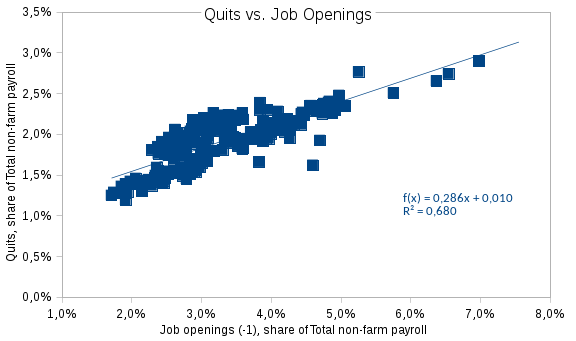The Great Resignation wave of quits has been worrying employers all over the world for many months already. In a series of articles (see here and here) on this topic I try to apply a more data-oriented approach and to discover some patterns of employee behavior. In this note, I provide some basic ideas on how the links work in the Bureau of labor statistics (BLS) data and how to create a simple forecasting model for quits in the US economy.
The Idea
Common sense advises that quits and job openings are somehow connected. The most compelling explanation would mention the following factors:
- for employees to quit there must exist some other jobs at which these employees can work;
- companies need to be actively hiring in order to create a pool of jobs large enough for employees to choose from and find a suitable new workplace;
- job switch takes some time, hence job openings should be created in advance so that employees can negotiate the new contract terms and other details before they decide to quit;
- the new jobs need to be offering financial or career improvements for someone to be eager to leave the comfort of their current working place.
The Model
The chart below based on BLS monthly data for the years 2001-2021 shows that most of the factors mentioned indeed seem to be relevant to the actual quits process.

Job openings show a close connection to the workers’ decision to leave their current workplace. Note that the jobs created are shown on the chart with a one month lag. It is clear that the more job openings were generated by the economy in the previous month the more quits follow in the next month. Naturally, data seem to confirm that the process goes like this: employees see that new opportunities exist and that there’s is a sufficient pool of new openings to choose the fitting new career, so they take some time to make the necessary arrangements and finally do switch their jobs.
Checks
Several robustness checks were performed. Among them were using other lags and more lags for the job openings variable, using non-employment-weighted absolute values for both parameters, adding other possible variables (the same BLS report data parameters, e.g. layoffs and discharges, were used as an alternative reason for leaving the job). However, the basic results stay stable and continue to imply a strong connection between job openings and quits. At the same time, the increased pay or other income influence on quits (the 4th bullet in the list above) has not been checked in order to keep the model simple. Nevertheless, all the results here should be taken with great caution and used only as the first step for more serious and profound analysis.
Conclusion
In conclusion, a handful of observations regarding the Great Resignation can be made even with such a simplistic model:
- people tend to wait for the real opportunities to appear, they usually do not quit to nowhere;
- the current increase in resignation fits nicely to the historical data patterns;
- it is highly likely that as the employment pick up subsides, the quits wave will also go down.
